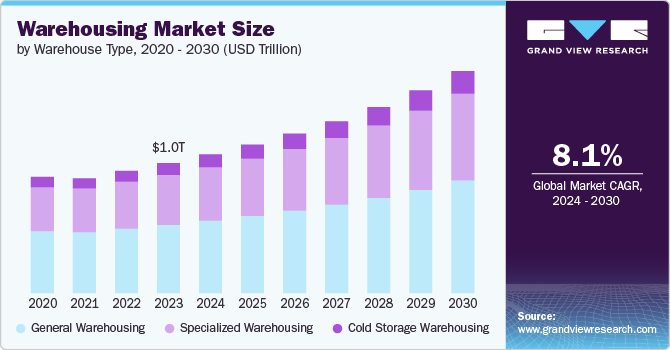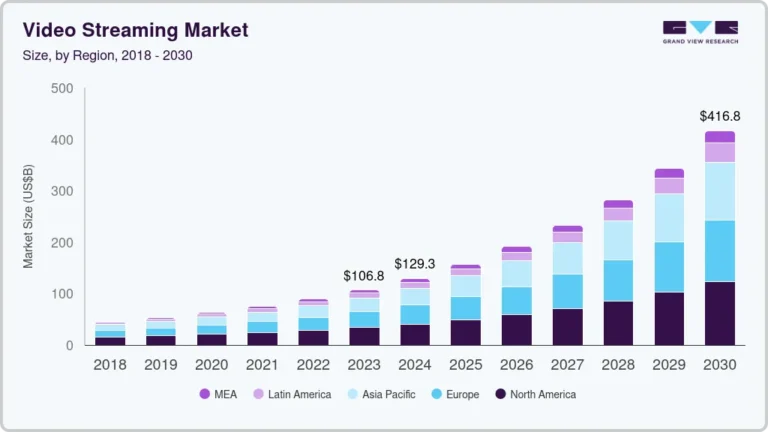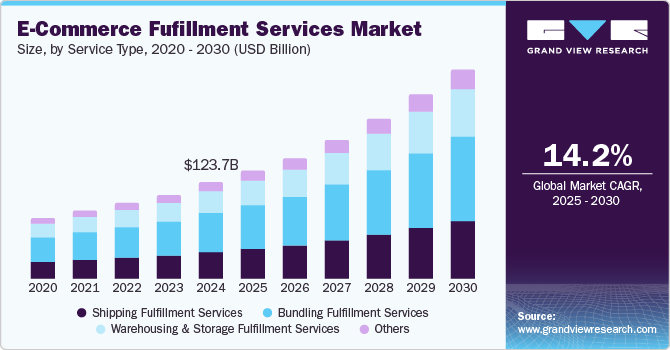Internet Of Things In Warehouse Management Market Size, Share & Trends Analysis growing at a CAGR of 8.3% from 2025 to 2030

The global internet of things in warehouse management market size was estimated at USD 11.26 billion in 2024 and is projected to reach USD 17.93 billion by 2030, growing at a CAGR of 8.3% from 2025 to 2030. The growth is attributed to increasing demand for automation and efficiency in supply chain operations.
Key Market Trends & Insights
- The North America IoT in warehouse management market dominated with the largest revenue share of 34.8% in 2024.
- The U.S. IoT in warehouse management market dominated North America in 2024.
- By device, the IoT sensing devices segment in IoT in warehouse management industry accounted for a significant revenue share in 2024.
- By application, the inventory optimization segment dominated the IoT in the warehouse management industry, with the largest revenue share in 2024.
- By enterprise, the large enterprise segment dominated the IoT in the warehouse management industry, with the largest revenue share in 2024.
Market Size & Forecast
- 2024 Market Size: USD 11.26 Billion
- 2030 Projected Market Size: USD 17.93 Billion
- CAGR (2025-2030): 8.3%
- North America: Largest Market in 2024
Request a free sample copy or view report summary: https://www.grandviewresearch.com/industry-analysis/internet-of-things-iot-warehouse-management-market/request/rs1
As companies strive to enhance their operational capabilities, the integration of internet of things (IoT) technologies allows for real-time monitoring and management of inventory, which is crucial for maintaining competitive advantage. The rapid digital transformation across various industries has further driven the IoT in the warehouse management industry. Organizations are increasingly recognizing the importance of data-driven decision-making and operational visibility, leading to a surge in the adoption of IoT-enabled devices such as sensors and RFID tags. These technologies facilitate improved tracking and management of goods within warehouses, resulting in reduced operational costs and enhanced accuracy. The shift toward e-commerce further amplifies this trend, as companies require agile and efficient warehouse operations to meet consumer expectations.
Moreover, regulatory pressures regarding safety and compliance are encouraging businesses to adopt IoT solutions that ensure adherence to industry standards. As governments implement stricter inventory management and logistics regulations, organizations invest in technologies that enhance transparency and traceability within their supply chains. This trend is particularly evident in healthcare and food distribution sectors, where compliance with safety standards is paramount.
Furthermore, IoT connectivity and sensor technology advancements have made these solutions more accessible and cost-effective for businesses of all sizes. Smaller enterprises can leverage IoT technologies to optimize their warehouse operations as implementation costs decrease. This democratization of technology is expected to drive further growth in the IoT in the warehouse management industry as more organizations recognize the potential benefits of integrating IoT into their logistics strategies. Overall, the combination of these factors positions the global IoT in the warehouse management industry for robust expansion over the coming years.
Device Insights
The IoT sensing devices segment in IoT in warehouse management industry accounted for a significant revenue share in 2024, due to the increasing need for real-time inventory tracking and management. These devices, including RFID tags and smart sensors, provide critical data that enhances visibility and accuracy in warehouse operations, allowing businesses to continuously monitor stock levels and conditions. Companies that utilize IoT sensors have reported a reduction in inventory errors, which directly translates into cost savings and improved customer satisfaction. In addition, the growing emphasis on automation and efficiency in supply chains drives the adoption of these technologies, as they facilitate streamlined processes and reduce reliance on manual labor.
The IoT connecting gateways segment is expected to grow at the highest CAGR over the forecast period due to the increasing demand for seamless data integration and communication within warehouse management systems. These gateways serve as critical links between IoT devices and central management systems, enabling real-time data transmission and analytics that enhance operational efficiency. For instance, a warehouse utilizing IoT gateways can instantly relay information about inventory levels and equipment status, allowing managers to make informed decisions quickly. The growing complexity of supply chains and the need for improved visibility are driving businesses to adopt these gateways, as they facilitate better coordination among various stakeholders. In addition, advancements in connectivity technologies, such as 5G, are further enhancing the capabilities of IoT gateways, making them essential for modern warehouse operations that rely on real-time data to optimize processes and reduce costs.






